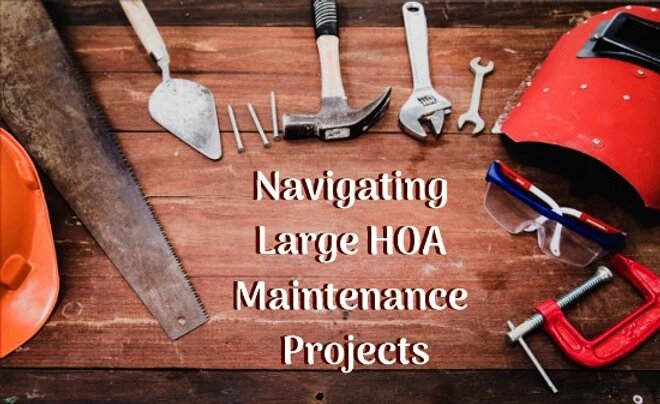In lieu of a special assessment for the project, a loan can defray the cost over time and it will impact the reserve the least.

Navigating Large HOA Maintenance Projects
Eventually, an HOA board must brace itself for major construction, reconstruction or infrastructure projects. It’s taken for granted by boards that they will be eventually be required to install new sewers, remove trees or completely replace roofing – all projects that take a big chunk out of an annual budget. With a single family home, the homeowner may need a loan to underwrite the costs of a project; the same alternative can work for an HOA. Because the cost of major projects is shared by the homeowners, a special assessment could cover the cost, but if major reconstruction is required for a large development, financial assistance could be a more favorable alternative. If a board decides against a special assessment for the project, a loan can defray the cost over time and it will impact the reserve the least.
Steps Prior to Project Start
1. Perform Reserve Study: Even if your reserve study finds the HOA short of immediate cash for a large project, the need may supersede the cost. A reserve study helps to ascertain the financial health of the HOA, includes a financial analysis of the HOA, and explores financial alternatives in funding future projects. A reserve study will also include a needs assessment that will detail which projects should be addressed as the community ages.
2. Hire a Construction Manager to Perform a Site Review: a construction manager is not the same as the contractor. He is the “middleman” who keeps the Contractor(s) on schedule and reports back to the HOA Board and property manager. Construction managers are vital to maintaining communication between the various parties and helps to make sure the involved parties are paid during the course of progress payments. He will make sure that all the substantive details of each segment of the project are performed as required.
3. Site Review: in order to assess project cost, a site review is a must. For example, replacing sewer lines is not as simple as removing and replacing just the sewer lines themselves. It could require city permits, reserved parking (if the development does not have enough existing parking for contractor vehicles), tree removal services, concrete, and landscaping services. The construction manager, in tandem with the HOA board, performs the site review – the construction manager, because of his expertise, and the board, because of its knowledge of the property.
4. Write Project Specification: after the site review, the construction manager will compile the project specifications. These not only include the building aspects of the project but ancillary items such as storing equipment and materials, proper disposal, permits, sanitation, safety, timelines, payment schedules, warranty of work, certificates of insurance, and copies of contractors’ licenses. At this point, the construction manager should supply a report to the HOA board with recommendations for contractors and an overall estimate of the cost based on prior similar projects.
5. Request Bids: After the construction manager has compiled his specifications and provided the HOA board with his report, the board may wish to preliminarily vote for the construction manager to move forward with requests bids for the project or the various project segments, if applicable. This may take some time as the construction manager, property manager and/or board president may obtain several bids and testimonials for each contractor. During this time, if a loan is the best financial alternative, it is time for the HOA’s accountant to try and remove as many negatives as possible from its balance sheet (fines, late fees, or foreclosures). The cleaner the HOAs books are, the more likely the association is to obtain a loan at a favorable rate. Once bids are gathered and contractors voted upon at a board meeting (which may take up to 2 months to complete), it’s time for the next step.
Project Commencement
After choosing contractors but prior to actual project start, the parties must sign a contract and a Notice to Proceed. The latter specifies the project start date and what paperwork (contractor’s license, certificate of insurance, contact lists) will be required of the contractor. After the necessary documents are signed and compiled, the construction manager schedules an on-site meeting with the contractor to assess the construction site to minimize impact upon the residents and to the surrounding homeowners, as well as city-owned property. If multiple buildings are under construction, as in the case of a complete roofing upgrade, it’s important to discuss a project timeline, as well as inspection and payment schedule. If weather impacts progress and therefore progress payments, frequent communication among all parties is a must.
Schedule and Completion
Depending on the type of project, a start date must be chosen. Obviously, in rainy climates, it’s unwise to start a roofing project during the rainiest month of the year. Generally speaking, regardless of the location, spring is the start of drier weather (more specifically, from May through October). Unless it’s a smaller community, this should be a rule of thumb, even for sewer projects where water runoff can affect worker access. A schedule of approximately 4 to 6 months can cover both the preliminaries (from hiring a construction manager to signing contracts) and the job itself. If the job involves extensive reconstruction of a larger community, it may mean a schedule spanning more than one calendar year.
During the project preparation, it behooves the HOA board to keep residents advised of any obstructions, noise, blockages, as well as of progress and expectations. It’s also important to keep in touch with contractors to ensure the job is being performed on schedule and without incident. Keeping all parties in the loop will make the job run smoothly and lessen the likelihood of delays. Once completed, the board and construction manager must perform a walk-through to make sure all work is done to specification.
Staying on top of maintenance helps the HOA avert emergencies and plan for necessary projects. Creating a plan for large projects is critical for the long-term well-being of the community to not only maintain the quality of living but property values as well.
